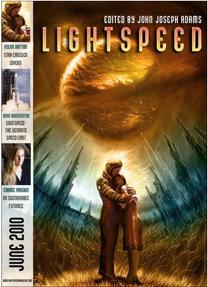 Lightspeed #1
Lightspeed #1
June 2010
“I’m Alive, I Love You, I’ll See You In Reno” by Vylar Kaftan
“The Cassandra Project” by Jack McDevitt
“Cats In Victory” by David Barr Kirtley
“Amaryllis” by Carrie Vaughn
Reviewed by Bryan Thomas Schmidt & Bob Blough
“I’m Alive, I Love You, I’ll See You In Reno” by Vylar Kaftan
“The Cassandra Project” by Jack McDevitt
Reviewed by Bryan Thomas Schmidt
“I’m Alive, I Love You, I’ll See You In Reno,” the first sale by author Vylar Kaftan is essentially a love letter from one lover to another recounting the history of their life-long love affair. Kaftan demonstrates an excellent gift for prose, weaving the narrative with descriptive and emotional language which keeps it moving at a steady pace and makes it moving to the reader’s heart.
The problem with the story is it feels like one long telling. There’s not really any showing. No dialogue to speak of. And the character development is limited to the narrator and limited at that. The story is enjoyable, but it could have been better; still, promising work from a new writer.
In Jack McDevitt’s “The Cassandra Project,” pictures sent back from the far side of the moon in 1967 are found to reveal a dome built there. As the Russians and Americans scramble to discover what it is and why no one noticed it before, two space agency press secretaries scramble to figure out what the Russian and American Presidents can say about it at a press conference only a few minutes away, when they announce a new joint US-Russian moon launch. When pictures from 1968 of the same area are found showing no dome, the mystery deepens. The Russians deny tampering with the 1967 photos, but despite orders from his boss, the NASA press secretary, Jerry, our protagonist, just can’t let it go. He begins digging further into the domes and the history of the crater where the pictures show it to be.
A good, old fashioned mystery story which reminded me of stuff I’d read in reprints from the old pulps, I enjoyed this story much more than the first one. When the mystery begins to be revealed, parts of it reminded me of some of the best episodes of Lost. What the dome turns out to be and what happened to it are revealed with some nice twists and surprises. Recommended.
“Cats In Victory” by David Barr Kirtley
“Amaryllis” by Carrie Vaughn
Reviewed by Bob Blough
The Carrie Vaughn story “Amaryllis” takes place after the destruction of life and culture as we know it. The world’s rebuilders have created a world of moderation rather than surplus.
“Surpluses must be penalized, or everyone would go fishing for surpluses and having spare babies, and then where would we be? Too many mouths, not enough food, no resiliency to survive disaster, and all the disease and starvation that followed. I’d seen the pictures in the archive of what had happened after the big fall. Just enough and no more. Moderation.”
It’s an interesting set up. The story revolves around the captain of a boat whose crew is also her chosen family. Marie, the captain, has a shady past as her mother broke the “law” of moderation by having her without permission. This past wound has created problems with certain people in the community and she must battle her own sense of self-worth to finally stand up for herself. It’s not a bad story but not very strong either.
The final story deals with cats that have been turned into “men”–much like Cordwainer Smith’s cat people–but less subtly written and not so disarmingly fascinating. “Cats in Victory” by David Barr Kirtley tells the story of the catmen who have killed off most of the other talking species–birdmen, dogmen, frogmen and monkeymen. It does not take much thought to realize who these “monkeymen” are. We are proven right when a human being who had been buried in his wrecked spaceship survives into this future world.
This is a tired retread of themes that could have been a fascinating exercise in creative Science Fiction. This story, however, has catmen who think and speak just like humans (except for their obvious curiosity as in ”curiosity kills the…”). The religion they have developed is overly predictable as well. David Barr Kirtley does have a very clear writing style. In the future, if he allows his imagination to really take off, he could bring us stories with wonder attached.
Lightspeed, a new monthly e-zine launched the summer of 2010, can be found at http://www.lightspeedmagazine.com/.